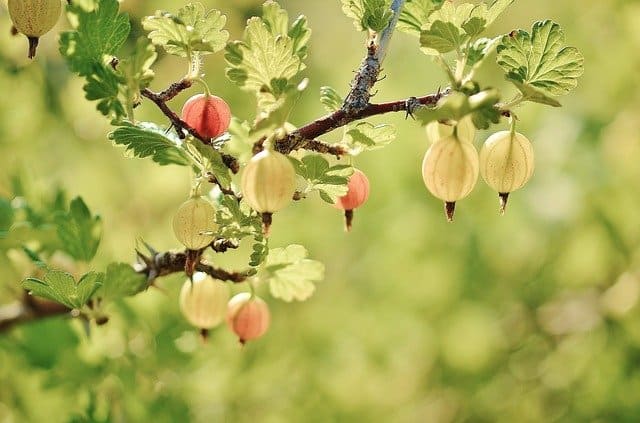You can get rid of Gooseberry Sawfly caterpillars by spraying Neem oil, Garlic spray, or an organic pesticide like Pyrethrum. You can control them biologically by introducing parasitic nematodes onto the infected plant. To prevent further infections add Diatomaceous Earth to the soil around the plant.
Gooseberry plant is grown in gardens for their fruits. Gooseberries are rich in a number of nutrients, they are especially good for healthy hair.
If everything goes well, they give nice fruits. What if something goes wrong? Gooseberries are famously attacked by Sawflies.
Sawfly larvae feed on the gooseberry foliage. They attack the plant during spring and summer. It’s crucial that you get rid of sawflies as early as possible.
Gooseberry Sawfly organic control
You can use Neem Oil and Garlic spray to control Sawflies on Gooseberry plants. Organic Pesticides that contain Pyrethrum can be used to control Sawflies on Gooseberry trees.
Gooseberry Sawfly Neem oil
Neem Oil can be used to control a Sawfly larvae infestation on Gooseberry trees.
Spray Neem oil in April when sawflies emerge fresh. Do not give them time to get established. Drench the bush in Neem oil.
How to use:
- You’d want to use a diluted solution. For general purpose use/preventive use, 0.5% to 1% mixture in warm water would work fine. Add 1-2 ml insecticidal soap to the warm water first, then add the oil.
- If you are working on a severely infected plant, you may increase the mixture to a 2% solution. The results are seen after a week.
- Use the Neem oil mixture within 8 hours of preparing it, otherwise, it’ll lose all its strength.
Do Rhubarb leaves kill Sawflies?
Rhubarb leaves can be used to treat a sawfly larval infection. Add some rhubarb leaves to water and let them stew. Spray this mixture all over the infected plant to get rid of the larvae.
Gooseberry Sawfly Washing-Up Liquid
You can use washing-up liquid to eradicate Sawfly Larvae on the Gooseberry plant. Sawfly larvae fall off the leaves and onto the soil. You can see them wiggle around the leaves once you spray this liquid.
Mix a small amount of washing-up liquid in water and spray it all over the plant.
Hand-pick such larvae and throw them into a bucket of soap water. Look for pinpricks in the leaves, here you’ll find a lot of larvae.
Garlic spray for Gooseberry Sawfly
Take 1-2 whole garlic bulbs and a quart of water. Crush the garlic and add it to boiling water. Add some vegetable oil/washing-up liquid to this mixture and cover the bowl with a lid overnight.
You can now use this as a spray for sawfly larvae. It is quite effective against these pests, I personally used it a while ago and am satisfied with the results.
This spray is very good because it also deters other pests like slugs, fungi, aphids, etc.
Organic Pesticide for Gooseberry Sawfly
Organic pesticides are my go-to when I see my plants severely infected by pests. ‘Pyrethrum’ works wonders against sawfly.
Buy a Pyrethrum product that can take dilution. Dilute it well and spray it on the leaves where you see caterpillars.
Only spray Pyrethrum in the evenings when the bees are inactive. Pyrethrum can kill insects on the touch, so it’s harmful to bees as well.
Nematodes Gooseberry Sawfly
Nematodes can be used to effectively control sawfly larvae on gooseberry plants. These nematodes are available in your local horticulture stores.
Biological control is useful when the infestation is in the initial stages. This method is quite effective and is safe for the plants too.
These nematodes enter the body of sawfly larvae and infect them with a bacterial disease. These nematodes should be introduced in cold, damp weather.
How to prevent Gooseberry Sawfly?
There are various ways to prevent a Sawfly larvae infestation on gooseberry bushes. It’s always better to deter pests than fight them.
Gooseberry Sawfly Diatomaceous Earth
You can sprinkle Diatomaceous earth around the base of the Gooseberry tree. This helps to prevent the sawfly from forming a cocoon thus breaking the lifecycle at a crucial stage.
This is a good way not only because it works but also because it’s completely natural.
Other ways
- Planting garlic around your Gooseberry bush will deter such pests.
- You can underplant your Gooseberry plant with Lavender plants, the larvae won’t be able to find the Gooseberry bush this way.
- You can hang a bird box near the Gooseberry plant. The birds will take care of the larvae for you!
- You can spray Neem oil at the time when you suspect those pests’ eggs will hatch. It works wonders to prevent a large-scale infection.
What does Gooseberry Sawfly look like?
It’s important to identify the pest properly to get rid of it effectively. Gooseberry sawflies are called caterpillars too, so you can guess what they look like.
Adult Gooseberry sawflies are yellow with black markings and black-colored heads. These adults lay eggs that turn into larvae.
The larvae are pale green in color and have black spots on the body. Their heads are black and these pests feed on the foliage.
Gooseberry Sawfly life cycle
You have to know your enemy before you go to war with him. Knowing the lifecycle of sawflies is important to devise a plan to get rid of them.
Where do Sawflies lay their eggs?
Adult sawflies emerge in April just in time as the leaves emerge. The adults lay their eggs on the undersides of the leaves.
These eggs turn into larvae and feed on the foliage for 2-3 weeks. Then the larvae fall down onto the ground and pupate.
The second batch of larvae(One that becomes active in July) feeds on the leaves too before falling onto the ground. This second batch overwinters in the soil.

